by Venchito Tampon Jr | Last Updated on January 16, 2022
Outreach is an effective way to form relationships with people who haven’t known/seen your brand, and are likely be interested to get more eyeballs to your content – either through contextual linking or social sharing.
It’s easy to look up successful case studies in acquiring links and getting more traffic through email outreach. The step-by-step process is mostly indicated, but those little changes one can make to turn a mediocre outreach email into a solid placement of links are sometimes ignored.
So, let’s take a look at some details that will improve the probability of getting the links you desire.
1. Validate Emails Scalably
Whether you’ve done large-scale campaigns or a one-time off outreach campaign, you always come across bounced emails.
These are email addresses that are either non-existent or maybe the receiving email server is temporarily unavailable, overloaded, or it couldn’t be found.
In general, you don’t have control over these bounced emails – but you can avoid receiving them by doing either of these two things:
- Check the validity of the email upfront.
- Find another email address that can be your second contact in case the first one bounces.
For the first solution, there are web-based tools that can aid you with validating emails – mailtester.com, and email-checker.net.
Doing so to each of your hundreds or thousands of emails can consume much of your time.
Instead, you can use Email Verification Tool to scale the validation of email addresses. This Google Sheet add-on below is easy to set up and automatically checks the email deliverability of emails.
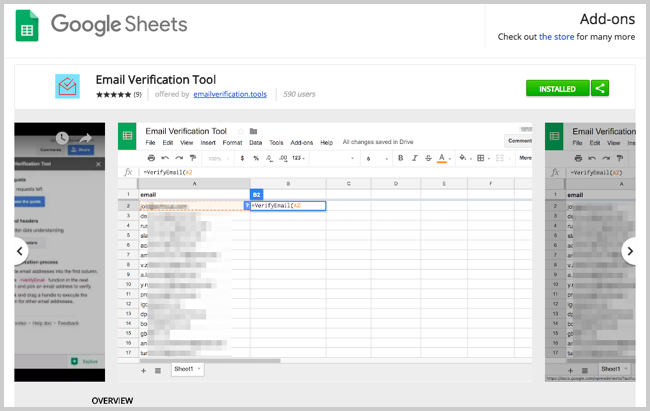
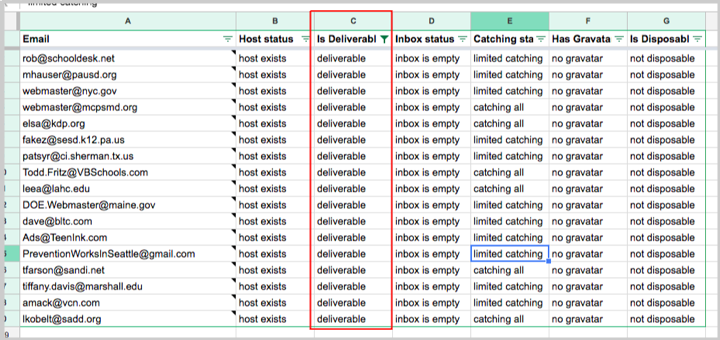
When emails are undeliverable, there are two options you can choose from:
- Find other ways to connect to your outreach prospect either through Twitter or Linkedin.
- Look for the next available contact person (editor, librarian, webmaster, etc..)
By scaling emails’ validity upfront, it’ll help you go for the next methods to connect to your link prospect. Not doing so is a waste of link opportunities you’ve developed for one specific website.
2. Ask “Who To Contact” For A Specific Page
When you’re sending outreach emails, chances are the people you’re reaching out to aren’t the first-hand persons who handle the desired page you’re trying to acquire a link from.
For those who know which person or department handles that single page and have been kind to send you the right contact person and his/her email address, you compose a new email, forward your original message, and send it to the new contact person.
That may not be always the case. Sometimes the thread of conversation gets longer until you found out he is not the right person to connect with for your link request pitch.
That said, one tip for you to add changes to your initial email is to ask who is the right person to contact.

You’ll be surprised because they can helpfully give you the exact name along with his/her email address.
No back and forth emails. Less waste of time you can instead spend talking to the right outreach person.
3. Give Context In Your Emails
It’s easy to copy and paste email outreach templates. But when you get replies like, “Which one?” or “what are you referring to?,” it’s another lazy approach to send another canned response to get the link immediately (and hopefully proceed to another email conversation).
Without your contact person getting the right understanding of your outreach email, it’ll be difficult for him to take any actions on your part.
One principle to consider is to always give the right context in your emails.
For example, if you’ve had the exact target page, it’ll be better to include the Page Title of the resource page in your first email – providing your outreach prospect with the right context of your pitch.
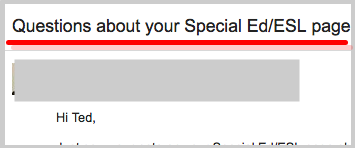
Relevance is crucially important in outreach. But when the context is misunderstood and/or not shown in pitches, it’d likely reduce your outreach placement rate.
4. Track Significant Rejections
Not all outreach campaigns succeed. For certain reasons, the link placements for target sites are not achieved – which lowers the conversion rate of the overall campaign.
Link building, in reality, is a hit-or-miss activity. Those misses particularly in outreach should be identified in order to make necessary steps, either to turn those rejections into link placements or better off use those rejections to make adjustments in one area of a link development campaign.
I’m a big fan of Stephen Covey’s principle of “Circle of Concern” and “Circle of Control”.
Basically, it shows two circles of choices that cover all the things in our life over which can just be concerned about or we can control of. These circles are called, “circle of concern” and “circle of control”.
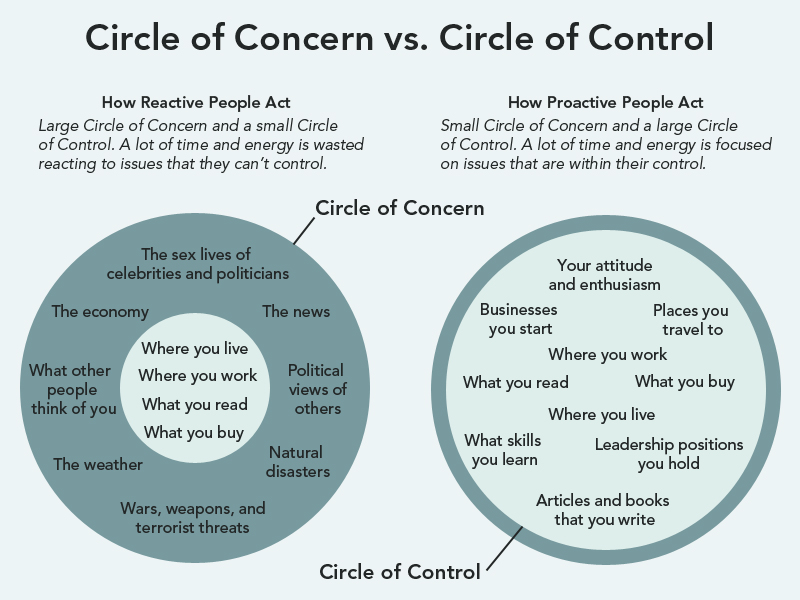
Applying that to outreach, we’ll be able to identify which rejections in emails we have control over (make adjustments if we can) or simply a concern (have to move on quickly).
Here are some examples of rejections in outreach and guess which ones you have control over —make adjustments with your content/outreach/prospecting) or a concern that can be considered as a loss or reality of the campaign.
- The webmaster you’re contacting is planning a website redesign (and may temporarily not be able to add any new external links).
- The daily schedule of the webmaster/link curator is tight and couldn’t do you a favor of adding the link.
- The content being pitched to is topically irrelevant to the target page/website.
- The page where content is hosted can’t be accessed or is displayed as an error.
There are a lot more examples I haven’t included here, but the point of bringing this up is to track rejections that are only significant for changes or improvements in your content – through developing its format, user experience, and other factors that can affect users’ trust. There may possibly be some necessary adjustments in your email’s subject line and email copy used overall, which can hugely impact how your message will be perceived by the webmaster.
5. Value Time Of Contact Persons By Showing The Value Of Your Pitch
Giving descriptions that your content is “amazing,” “comprehensive,” “ultimate,” or “complete” (even if it’s not) while not showing why it can be described as such takes more seconds of reading your email than it actually should’ve provided value to your contact person.
Here are some tips to intelligently describe your content in email pitches:
- Let them know the format of your content piece. While this can be added straight to the subject line, it’ll be more emphasized if it’s repeated on the email body.
- Give one or two-liner points of the utility and comprehensiveness of your content, particularly if you’re targeting resource pages where they’ve linked to similar pieces.
- Show actual social proof of the content – whose influencers and/or major local/niche media sites, for digital PR campaigns, the contact person may be familiar with that have linked to or mentioned your content asset.
Value the time your contact person will spend reading your email. By giving him enough reason to check out your content, you’ll have more chances of acquiring editorial links from his publication.
6. Follow-Up With Another Email Format
Sending follow-up emails to non-respondent prospects is one fundamental activity in outreach. There are other reasons why it is a must-do besides getting a response from someone who hasn’t read it.
- Take another chance with a non-respondent contact person who’ve read and seen the value of your pitch but hasn’t taken any action yet (the follow-up email can re-confirm the decision and push the action further).
- Knowing the best times and seasons to connect again for people saying “can you get back to me during summer or start of the school year?”. A follow-up email gives you a clue of their best moments to reach out to (make sure you take a note of this in your spreadsheet).
- Organize fairly your email contacts by changing relationship stages from In Communication to Not Interested those who are not really interested in your pitch – which saves a lot of your time sending them another email either from the same website/project or of another one.
There are two ways to approach follow-ups: sweet and short follow-up email or a follow-up that tells three options that they can choose from.
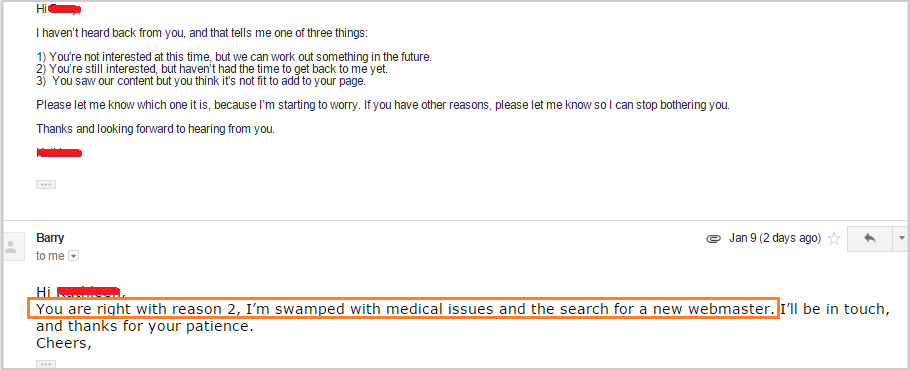
Don’t be lazy in sending follow-ups given there may be missed link opportunities you should’ve probably gotten if you skip on them.
One recommended practice is to create your own email experiments for your initial and follow-up email templates: A/B testing subject lines, email body, email sender, and any email fragments that are worth testing.
It is best to both have a bandwidth to do what already works (email outreach best practices) and have enough left for trial and errors in email experiments.
Need help with link building? Check out our link building services.
The Author
Venchito Tampon Jr
Venchito Tampon is a Filipino Motivational Speaker, Corporate Trainer, and a Leadership Speaker in the Philippines. He is the CEO and Co-Founder of SharpRocket, a link building agency. With a decade of experience, Venchito has a proven track record of leading hundreds of successful SEO (link builidng) campaigns across competitive industries like finance, B2B, legal, and SaaS. His expert advice as a link building expert has been featured in renowned publications such as Semrush, Ahrefs, Huffington Post and Forbes. He is also an international SEO spoken and has delivered talks in SEO Zraz, Asia Pacific Affiliate Summit in Singapore, and Search Marketing Summit in Sydney, Australia. Check out his other businesses, Hills & Valleys Cafe, Blend N Sips and Saas Pursuit.
How our LINK BUILDING AGENCY builds 250 links/mo consistently using Predictable Link Building Methodology™…
- Using a SIMPLE and PROVEN system
- Using a SCALABLE strategy
- No private blog networks
- No creepy outreach emails
